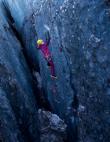Iceland 2.0
posted on Dec, 2021




During our first trip to Iceland in 2020 we were totally fascinated by it’s wild
nature and it’s large, untouched areas. This feeling of freedom made our
comeback home even harder, as only a few days after we arrived, the first
lockdown caused by the fast spreading of the Covid-19 pandemic hit us.
In the following weeks and months we had plenty of time to dream and there
was one thought that kept coming back - the glacier moulins we weren’t
able to climb during our first visit and that appeared so interesting. So we
started thinking about a second trip, this time in Autumn which is the best
period of the year to lower into the moulins. But then the second and the
third wave of the pandemic happened and we had to put our plans on hold.
In Summer 2021 my boyfriend Marco started chatting with a friend of us,
Jeff Mercier from France, who is one of the best ice climbers in the World, a
real wizard with ice axes and crampons. Jeff had been to Iceland the
Autumn previous to our first trip and had the chance to climb some moulins,
what made him hungry for more and so we started planning a trip together.
We were again accompanied by our Italian friend Matteo who lives in Iceland
and was ready to show us the best spots he had found. The first day Matteo
was keen to show us the new Drytooling crag he had developed close to
Reykjavik and me and Jeff were happy to start moving our body after a long
day of traveling. The routes were all really nice and the view above the bay
of Reykjavik was stunning.
The next morning we left in the direction of Vik, a little town located close to
Myrdallsjoekull glacier, where we wanted to spend the first two days of
climbing. And finally I got to see the moulins. When the ice on the surface
melts, the water searches and digs it’s way into the ground and creates
these vertical shafts. Glacier mills can reach hundreds of meters of depth,
the ones we climbed were 30 to 40 meters deep, the largest was about 70
meters. Lowering into one of those holes, not knowing how it’s interior
would look like was an absolute adventure. All of you who ever lowered
down along the blank walls of the Verdon gorge in France know that feeling
of exposure, doubt and excitement. In our case to the exposure was added
the fact that we were lowering into a narrow and dark hole, it’s not for those
who suffer from claustrophobia.
After the first two days in Vik we drove Southeast to the area of Skaftafell,
were we planned to spend the rest of our time. During the following days we
climbed every day on another area of the huge Vatnajoekull glacier. Every
moulin is completely unique and has it’s own form, color and depth. One day
the ice was white with dark stripes and at the first sight one could think it
was marble we climbed on, the next day the ice was totally transparent so
that we could see how the ice screw penetrated the ice and the following
day the ice was dark, colored by the volcanic ash enclosed in the ice.
To lower into the glacier was one of the most stunning experiences I ever
made, I had the impression that I was entering the ground just as if we were
taking part in Jule Verne’s ‘Journey to the centre of the Earth’.
The moulins are changing continuously, also because the glaciers in Iceland
are currently receding by dozens of meters every year and considering that
most of the moulins we visited were on the border of the glacier, next year
they will be different or they could also disappear completely. This specific
consequence of climate change makes me think about what I can do in my
life to diminish what is going on.
Our second trip to Iceland was for us also the first real trip abroad after two
uncertain years without international traveling and I really hope this will
close the circle.
I want to thank you once again Matteo Meucci for showing us so many
marvelous places.
back |
